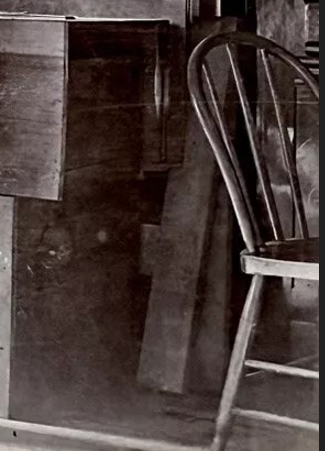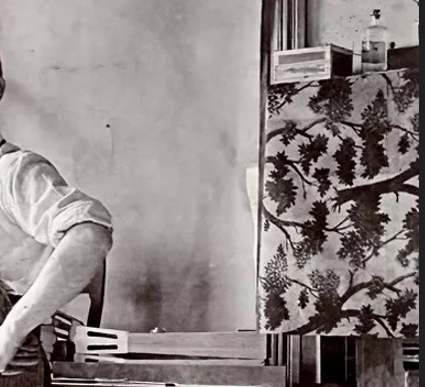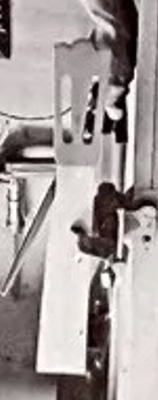 |
| Image Credit: Ebay - Ruby and Rad Vintage |
I saw this incredible photograph on Ebay of a luthier in his workshop with one completed instrument, numerous in-progress instruments, and a small collection of tools. I did not win the auction but I decided to embark on researching the origins of this photograph to give this man his identity back.
The Photo
I thoroughly enjoy old photos of craftsmen at their benches, I find a lot of inspiration for my own workbench layout as well as excuses to buy old tools just because I see them in these photos. I do wonder about what his day was like and whether he ever had an apprentice or a helper or he alone was responsible for building.
The first thing that caught my eye was the Windsor-style chair on the right side of the photo. Its relevant to absolutely nothing but I grew up with modern reproductions of this chair at our dinner table so it stands out as being something I can immediately identify with. We can see two boards, about as long as his bench is tall, leaned up against the wall and with fairly non-descript grain. I would wager that these are neck blanks or perhaps spruce for braces and three or four piece tops (which were more acceptable back then). I find it interesting that he attached boards to block off that end of the workbench.
On top of his bench, I don't see a 'tool well' that you might find with classical workbenches rather it appears to be simply a flat board. To his right we can see two necks in progress and the headstock of a third neck or perhaps a template leaning against the wall. He appears to be working in front of a mirror which I imagine has helpful properties in ensuring his work is illuminated from all angles. To his right is a shelf with foliage printed wallpaper or fabric hanging off and a box and glass bottle on top. I would guess that might be his alcohol or oil for french polishing.
The bench, itself, is interesting to me not only because the apron appears to be a single board, at least 15-18" wide, with continuous grain and visible sap wood at the top. You don't find trees like that anymore. He's gone ahead and built himself a large drawer (what I wouldn't give to see what's inside there...) with cast metal pulls. He includes a cut out in the apron to access a shelf filled with indiscernible objects and we can see his repurposed crates for storage. The bottom left looks like it says "Lump Starch" but I have no clue what that might mean. I can see a shape in that box which looks like a cut-off or a mold for a guitar body.
His leg-vise has a metal leadscrew as a nice improvement over the traditional solid wooden screws which would've been in use by generations before him. The board at the bottom with the staggered holes and peg prevents racking of the vise as you tighten it down on an object.
Next to the craftsman's hand is another neck in a unique vise that I'm not familiar with. It also gives us our best look at his signature headstock shape, this would be the key to identifying any of his instruments. Back to the vise.. Its small, like a jeweler's vise, but the ones I'm familiar with usually have an integral clamp so you can attach it quickly to your work surface. This might be mounted underneath with a screw and nut or partially inlaid into the top.
Here is where one can get real nerdy, real quick. Starting from the bottom, I now see that he is holding a rasp or file for the photograph. To the left of the neck is a hand plane laying on it's side and it appears to be a 'transitional' plane with a square wooden body and cast iron hardware for adjusting the blade. Handing on the wall is his bit brace for boring holes in the instruments. We also get a good view of one of his finished instruments with a pyramid bridge of ebony or rosewood, a distinctive cut-out at the end of his fingerboard, and fairly plain appointments on the top with a rosette and purfling.
Jumping up to the shelf and starting from the left, we can see three screw drivers leaning up against a tower of three boxes. Who know what treasures are in there. His draw knife is easily accessible hanging off the shelf and I believe I see a decorative molding cut into the bottom of the shelf. Above the draw knife is a metal block plane like you'd find today at the hardware store, the design hasn't changed a whole lot in a hundred years. I wonder if he bought a Union or a Stanley. To the right of that plane we see two more planes which are of an older, more traditional style. He has a 'coffin' plane sitting on top of another plane that looks to be two to two and a half times as long which should make that a 'jack' plane. The wooden style is adjusted with a mallet rather than the slick adjusters found on the plane sitting on his bench or the block plane on its side. Perhaps that's why these are sitting behind a row of six smaller objects and two circular objects. I suspect the small pieces to be violin-makers planes which are tiny planes held between your fingers for delicate work and graduating the top and back of a violin. I have no clue what the circles are.
Lastly we see the roughing tools for his stock prep. A large saw for ripping boards and a hatchet for hewing or splitting his spruce brace stock.
The Search
The back of the photograph has an ink stamp advertising "The Bowen Art Studio" at "46-1/2 North Meridian Street" in Anderson, Indiana. I wasn't familiar with Anderson but found that it lies between Indianapolis and Muncie, closer to Muncie, and is the seat of Madison County. As I was searching through old maps, it seems like a typical, small industrial city with a lot of people employed as general laborers. The population doubled from 10,000 in 1890 to 20,000 in 1900 so there was no shortage of new people looking to make their start.
This style of photograph which is affixed to a cardstock backer seems to be most popular in the late 1800s, I believe its called a cabinet card, and remained popular up until the introduction of personal cameras in the teens. As I've found in my previous research, the late 1880s saw a boom in small, local shops building guitars and mandolins for the newly emerging middle class. This lasted until the First World War when labor became difficult to come by and tuners and purfling from Europe became inaccessible.
I located the photo studio in an 1890 Sanborn map of the city and found it was above a barber shop near the center of town. I scoured the map hoping for a building labelled as a manufacturer of musical instruments, I haven't seen it yet on one a small operation but I can dream. I found nothing.
 |
| Image Credit: Library of Congress - Sanborn Map c.1890 |
Anderson was not as easy to find specific information about as many of the other towns I've come across. Documents from these periods do exist but they are not as accessible online as I'm used to and without owning one of these guitars, I'm not quite ready to drive four and a half hours.
A Lead
After coming up blank on Ancestry and FamilySearch, I ended up getting a trial to MyHeritage which is another ancestry-mapping website with a slightly different set of historical documents. None of these websites expect you to be searching for anything other than names of people in certain places at certain times, they're geared towards you having an idea of who you are looking for. It becomes more difficult when you are searching by occupation or street address especially since they don't usually want you combing through the pages of their scanned books, they'd rather send you directly to a record for a person. Ancestry is the easiest to navigate, MyHeritage was a little trickier.
In the 1891 Anderson City Directory (the only one they had), I found a single person listed as a musical instrument manufacturer. S. C. Cochran who had set up shop on 111 1-/2 North Main Street! As we found with the photo studio, this would probably be on the second floor.
 |
| Image Credit: MyHeritage |
And on the same 1890 Sanborn map, I found the address which places his shop above a plumber's
It was rather difficult to find any matching individuals on any of the research websites, the closest lead I found was for a Simon or Simeon Cochran who was a carpenter in the 1900 census.


















No comments: